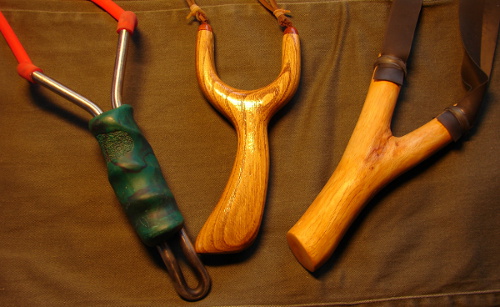














The frame of a slingshot is the rigid, typically Y-shaped part that is held in the hand. A proper frame holds the bands safely, makes shooting comfortable and gives you a proper sight picture, if this is beneficial to your shooting style. Yet, I must stress that the frame itself has not much to do with a slingshot's performance. Most experienced slingshooters can take pretty much any frame and shoot accurately with it after some time of training. Only models with extension of the drawing length by elongated forks or roller systems have an influence on the rubber band's performance.
Making a slingshot frame is a rewarding activity. Some people like the construction of a slingshot more than actually shooting it, and there's nothing wrong with that. There are many different ways to make a frame - I've seen slingshot carved out of stone, sewn from heavy leather, molded with epoxy resin - but the majority of the slingshot can be sortet into one of the following three categories:
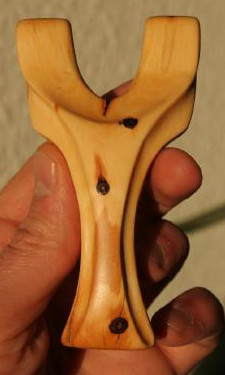
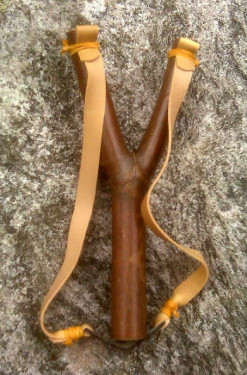
Every child in the world that had the luck to grow up in a rural area made a slingshot out of a tree fork. This sometimes leads to the notion that tree fork slingshots are toys, or somehow inferior to other designs. Nothing could be further from the truth. Many Top-notch shooters attend (and sometimes win) tournaments with them.
Natural forks have a number of charming advantages. First, they are usually free to obtain. Second, they can withstand a lot of force if dried correctly - the fibres in the branches run always along the curves, which is not the case in a board cut slingshot. Third, many tree forks grow in a shape that makes them fit the hand without much carving work.
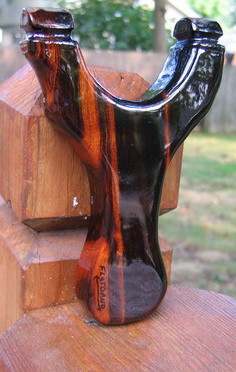
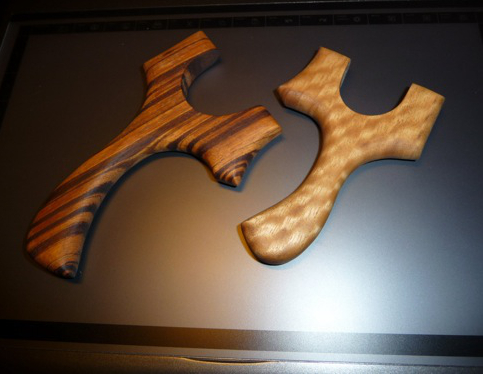
In Europe and the USA, the most popular type of slingshots are board-cuts. The
name says it all - they are cut from a plank of wood, or sometimes a metal or Micarta
sheeting. The big advantage of making a board-cut is that there is almost no limit
on its shape. Fork height and width, grip angle etc. can be matched perfectly to
the shooter.
Be careful to choose the proper wood for you board-cuts. Let the fibres (which run
along the tree's growing direction) also run vertically on your slingshot. Use good hardwood
only, and keep the throat area, where the forks meet the grip, large enough to withstand
the forces that will rest upon it. Plywood is a good alternative to hardwood, and I recommend
it if you are unsure what wood to take. Have a look in the Template section to see some good
designs.
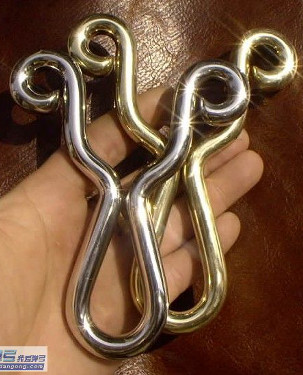
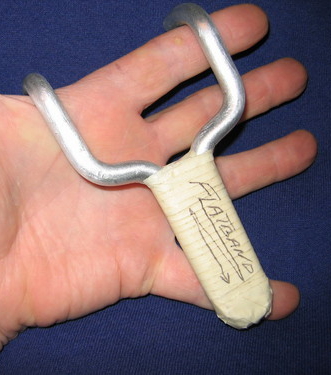
Another common material are bent metal rods - starting with a bent coathanger that is a typical child's slingshot, and ending with sophisticated models made from hot-bended metal rods. Most mass produced slingshots are bent-wires, with plastic handles to increase their ergonomy. The advantage is the high stability, in a small package: A well made bent-wire from 6mm steel rod can take about any band strength, while being slim and easy to stash in the pocket. However, this material choice puts some limitations to the possible designs, and band attachment types. Additional parts - such as rubber wrapping or a wooden handle- are often necessary to augment the metal frame's ergonomy.